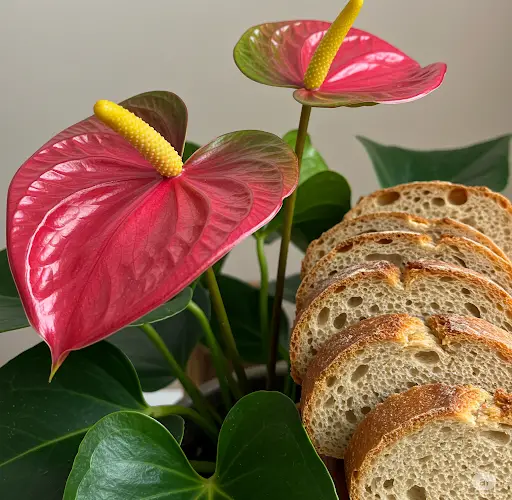Anthuriums are among the most eye-catching houseplants, admired for their vibrant blooms and shiny, heart-shaped leaves. While they are relatively easy to care for, getting them to flower regularly can sometimes be a challenge. Many plant lovers spend money on commercial fertilizers or flowering boosters, unaware that a simple kitchen ingredient can work wonders—a plain slice of bread.
Yes, bread. This everyday item, when used correctly, can act as a mild organic fertilizer that supports root health, enriches the soil, and stimulates blooming. With minimal effort and zero chemicals, this trick offers a natural way to help your Anthurium thrive and produce those signature waxy flowers more often.
Why Bread Can Help Anthuriums Bloom
Although bread isn’t a traditional plant fertilizer, it provides several surprising benefits when added in moderation to potting soil:
-
Source of Carbohydrates
Bread is rich in carbohydrates, particularly starches, which help feed the beneficial microbes in the soil. These microbes improve nutrient cycling and make essential minerals more available to the plant. -
Contains Trace Nutrients
Bread contains small amounts of proteins, minerals like calcium and iron, and even a bit of natural yeast. These elements support plant health when broken down by soil organisms. -
Improves Soil Microbial Activity
The breakdown of bread encourages microbial life, which is essential for a healthy root zone. Active microbial ecosystems in the soil lead to better nutrient absorption and improved flowering potential. -
Acts as Organic Matter
As bread decomposes, it becomes part of the soil structure, helping retain moisture and improving aeration—both key to keeping Anthuriums happy.
How to Use Bread on Anthuriums
To safely and effectively use bread to support your Anthurium’s blooming, follow this easy method:
1. Choose Plain Bread Only
Use plain white or whole wheat bread without added sugar, salt, preservatives, or seasonings. Avoid breads with raisins, seeds, or garlic, as these can harm your plant or attract pests.
2. Tear into Small Pieces
Tear or cut the bread into small pieces to help it decompose faster in the soil. One slice per medium-sized pot is enough.
3. Bury the Bread
Place the bread pieces in the potting soil, around the edges of the container. Bury them about 2–3 centimeters (1 inch) deep. This keeps insects away and allows the bread to break down slowly underground.
4. Water Normally
Water the plant as usual after burying the bread. Moisture will activate decomposition and encourage beneficial bacteria to start working.
5. Use Once a Month
Limit this practice to once a month. Too much bread can lead to fungal growth or unpleasant odors if the pieces do not break down properly.
Additional Tips for Thriving Anthuriums
While a bread slice can give your plant a gentle boost, overall plant care still plays a major role in bloom production. Keep these best practices in mind:
-
Light: Place your Anthurium in bright, indirect sunlight. Too much direct light can scorch the leaves, while too little will result in slow growth and no flowers.
-
Humidity: These tropical plants thrive in high humidity. Mist the leaves regularly or place a humidity tray nearby to keep the environment moist.
-
Watering: Water when the top inch of soil is dry. Avoid overwatering, which can lead to root rot.
-
Soil: Use a well-draining, peat-based mix. Good drainage is essential to prevent root diseases and nutrient build-up.
-
Cleaning: Dusty leaves block sunlight and reduce photosynthesis. Wipe them gently with a damp cloth every couple of weeks.
-
Fertilizer: While bread offers some nutrients, you can also use a diluted liquid fertilizer every 6–8 weeks during the growing season for optimal results.
What to Expect Over Time
You may not see instant results with the bread method, but with consistent monthly application and proper care, you should notice your Anthurium producing healthier leaves and eventually sending out more flower spikes. The key to this natural method is patience—it works gradually by improving soil quality and stimulating the plant’s natural blooming rhythm.
Unlike chemical fertilizers, bread is gentle and won’t burn your plant’s roots or disrupt the soil’s delicate balance. It’s also a budget-friendly way to reuse food scraps while nurturing your indoor garden.
Conclusion: A Natural Trick for Spectacular Flowers
With just a slice of plain bread, you can give your Anthurium the gentle push it needs to bloom more often and grow with greater vigor. This method is easy, natural, and surprisingly effective. When combined with proper watering, light, and humidity, your Anthurium will reward you with stunning, long-lasting blooms—all with the help of an ingredient you likely already have in your kitchen.
Give it a try and watch your plant respond with fresh, healthy growth and vibrant flowers.



